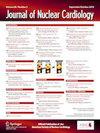心脏炎症 FDG PET 的自动深度学习分割。
IF 3
4区 医学
Q2 CARDIAC & CARDIOVASCULAR SYSTEMS
引用次数: 0
摘要
背景:抑制心肌葡萄糖利用的氟脱氧葡萄糖正电子发射断层扫描(FDG PET)在诊断心脏肉样瘤病方面发挥着关键作用。调整图像方向以匹配灌注数据集和心肌分割可实现一致的图像缩放和量化。然而,这种手动任务非常繁琐。我们开发了一种三维 U-Net 深度学习(DL)算法,用于在心脏肉样瘤 FDG PET 中自动进行心肌分割:DL模型是在316名患者的FDG PET扫描上训练出来的,其左心室轮廓来自成对的灌注数据集。对临床可读性进行了定性分析,在 50 名患者的测试子集中比较了 DL 分段与当前的自动方法。此外,还将左心室位移和角度以及 SUVmax 取样与用户间的可重复性结果进行了比较。此外,还研究了一种混合工作流程,以加快研究处理时间:结果:与软件目前使用的标准分割相比,DL分割提高了90%以上病例的可读性评分。DL分割的表现与训练有素的技术专家相似,在左心室位移和角度以及SUVmax相关性方面超过了标准分割。将DL分割作为手动分割的初始位置大大缩短了处理时间:结论:基于 DL 的新型自动分割工具明显改善了心脏肉样瘤 FDG PET 的处理。该工具无需用户输入即可优化肉样瘤 FDG PET 数据集的飞溅显示,并显著缩短了此类数据集手动分割的处理时间。本文章由计算机程序翻译,如有差异,请以英文原文为准。
Automated deep learning segmentation of cardiac inflammatory FDG PET
Background
Fluorodeoxyglucose positron emission tomography (FDG PET) with suppression of myocardial glucose utilization plays a pivotal role in diagnosing cardiac sarcoidosis. Reorientation of images to match perfusion datasets and myocardial segmentation enables consistent image scaling and quantification. However, such manual tasks are cumbersome. We developed a 3D U-Net deep-learning (DL) algorithm for automated myocardial segmentation in cardiac sarcoidosis FDG PET.
Methods
The DL model was trained on FDG PET scans from 316 patients with left ventricular contours derived from paired perfusion datasets. Qualitative analysis of clinical readability was performed to compare DL segmentation with the current automated method on a 50-patient test subset. Additionally, left ventricle displacement and angulation, as well as SUVmax sampling were compared with inter-user reproducibility results. A hybrid workflow was also investigated to accelerate study processing time.
Results
DL segmentation enhanced readability scores in over 90% of cases compared with the standard segmentation currently used in the software. DL segmentation performed similar to a trained technologist, surpassing standard segmentation for left ventricle displacement and angulation, as well as correlation of SUVmax. Using the DL segmentation as initial placement for manual segmentation significantly decreased the processing time.
Conclusion
A novel DL-based automated segmentation tool markedly improves processing of cardiac sarcoidosis FDG PET. This tool yields optimized splash display of sarcoidosis FDG PET datasets with no user input and offers significant processing time improvement for manual segmentation of such datasets.
求助全文
通过发布文献求助,成功后即可免费获取论文全文。
去求助
来源期刊
CiteScore
5.30
自引率
20.80%
发文量
249
审稿时长
4-8 weeks
期刊介绍:
Journal of Nuclear Cardiology is the only journal in the world devoted to this dynamic and growing subspecialty. Physicians and technologists value the Journal not only for its peer-reviewed articles, but also for its timely discussions about the current and future role of nuclear cardiology. Original articles address all aspects of nuclear cardiology, including interpretation, diagnosis, imaging equipment, and use of radiopharmaceuticals. As the official publication of the American Society of Nuclear Cardiology, the Journal also brings readers the latest information emerging from the Society''s task forces and publishes guidelines and position papers as they are adopted.

 求助内容:
求助内容: 应助结果提醒方式:
应助结果提醒方式:


